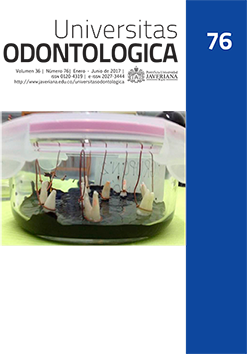Abstract
ABSTRACT. Background: Predoctoral education requires student dedication to meet academic demands and learning goals with quality. University professors often complain that students do not regulate their learning strategies and are unable to act autonomously in their professional training. Purpose: To analyze the use of self-regulated learning in dental students at a Colombian public university. Methods: A descriptive study was carried out using Lindner et al.’s Self-Regulatory Learning Inventory, 4.01 version. The inventory includes four training areas (executive, cognitive, motivation, and environment control) among fourth semester dental students (sophomores) of University of Cartagena in Colombia. Results: The average use of self-regulated learning by the dental students was low. Furthermore, the analysis shows that the score in the scale (60-119) leads to a deficient level of learning (p<0,05). Conclusions: Marked weaknesses in the group of students intervened were identified who, in some cases, did not meet adequate self-regulated learning levels for their current year of study.
Wouters A, Croiset G, Galindo-Garre F, Kusurkar RA. Motivation of medical students: selection by motivation or motivation by selection. BMC Med Educ. 2016; 16(1): 37.
Niemiec CP, Ryan RM. Autonomy, competence, and relatedness in the classroom: Applying self-determination theory to educational practice. Theory Res Educ. 2009; 7(2): 133-44.
Lamas Rojas H. Aprendizaje autorregulado, motivación y rendimiento académico. Liberabit. 2008; 14(14): 15-20.
Lanz MZ, Difabio De Anglat HE, editors. Evaluación del aprendizaje autorregulado a través del inventario de Reinhart Lindner. Exploración de sus cualidades psicométricas. XIV Jornadas de Investigación y Tercer Encuentro de Investigadores en Psicología del Mercosur; 2007: Buenos Aires, Argentina: Universidad de Buenos Aires, Facultad de Psicología; 2007.
Orsini C, Binnie V, Evans P, Ledezma P, Fuentes F, Villegas MJ. Psychometric validation of the academic motivation scale in a dental student sample. J Dent Educ. 2015; 79(8): 971-81.
Atalayin C, Balkis M, Tezel H, Onal B, Kayrak G. The prevalence and consequences of burnout on a group of preclinical dental students. Eur J Dent. 2015; 9(3): 356.
John V, Lee S-J, Prakasam S, Eckert GJ, Maupome G. Consensus training: an effective tool to minimize variations in periodontal diagnosis and treatment planning among dental faculty and students. J Dent Educ. 2013; 77(8): 1022-32.
Henzi D, Davis E, Jasinevicius R, Hendricson W. North American dental students’ perspectives about their clinical education. J Dent Educ. 2006; 70(4): 361-77.
Henzi D, Davis E, Jasinevicius R, Hendricson W. In the students’ own words: what are the strengths and weaknesses of the dental school curriculum? J Dent Educ. 2007; 71(5): 632-45.
Lindner RW, Harris BR, Gordon WI. The design and development of the "self-regulated learning inventory": A status report. [Conference poster C7, session 27.28]. New York, NY: American Educational Research Association; 1996 Apr.
Alcota M, Fuenzalida A, Barrientos C, Garrido M, de Gauna PR, González FE. An “XL” endodontics intervention for dental students required to repeat the course: changing frustration to improved grades and attitudes. J Dent Educ. 2015; 79(4): 399-408.
Boekaerts M, Corno L. Self‐regulation in the classroom: A perspective on assessment and intervention. Appl Psychol. 2005; 54(2): 199-231.
Könings KD, Brand‐Gruwel S, Elen J. Effects of a school reform on longitudinal stability of students’ preferences with regard to education. Br J Educ Psychol. 2012; 82(3): 512-32.
Baeten M, Dochy F, Struyven K. The effects of different learning environments on students’ motivation for learning and their achievement. Br J Educ Psychol. 2013; 83(3): 484-501.
Schneider GB, Cunningham-Ford MA, Johnsen DC, Eckert ML, Mulder M. Outcomes mapping: a method for dental schools to coordinate learning and assessment based on desired characteristics of a graduate. J Dent Educ. 2014 Sep; 78(9): 1268-78.
Santibáñez MA, Sabando ÁR. Estudio preliminar sobre estrategias de aprendizaje en estudiantes universitarios de primer semestre, Pontificia Universidad Católica del Ecuador sede Santo Domingo. Axioma. 2016; (15): 86-95.
This journal is registered under a Creative Commons Attribution 4.0 International Public License. Thus, this work may be reproduced, distributed, and publicly shared in digital format, as long as the names of the authors and Pontificia Universidad Javeriana are acknowledged. Others are allowed to quote, adapt, transform, auto-archive, republish, and create based on this material, for any purpose (even commercial ones), provided the authorship is duly acknowledged, a link to the original work is provided, and it is specified if changes have been made. Pontificia Universidad Javeriana does not hold the rights of published works and the authors are solely responsible for the contents of their works; they keep the moral, intellectual, privacy, and publicity rights.
Approving the intervention of the work (review, copy-editing, translation, layout) and the following outreach, are granted through an use license and not through an assignment of rights. This means the journal and Pontificia Universidad Javeriana cannot be held responsible for any ethical malpractice by the authors. As a consequence of the protection granted by the use license, the journal is not required to publish recantations or modify information already published, unless the errata stems from the editorial management process. Publishing contents in this journal does not generate royalties for contributors.


